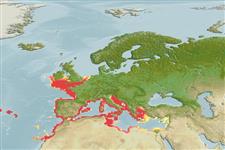Common names from other countries
Environment: milieu / climate zone / depth range / distribution range
Ecologia
; intervalo de profundidade 10 - 180 m (Ref. 113223). Subtropical, preferred 9°C (Ref. 107945); 53°N - 27°N, 32°W - 36°E (Ref. 114316)
Eastern Atlantic and the Mediterranean.
Length at first maturity / Tamanho / Peso / Idade
Maturity: Lm ? range ? - ? cm Max length : 11.0 cm SHL macho/indeterminado; (Ref. 109255); Idade máx. registada: 40 anos (Ref. 8702)
An active suspension feeder (Ref. 96376). Infaunal, found on sandy substrates (Ref. 113223).
Life cycle and mating behavior
Maturidade | Reprodução | Desova | Ovos | Fecundidade | Larvas
Members of the class Bivalvia are mostly gonochoric, some are protandric hermaphrodites. Life cycle: Embryos develop into free-swimming trocophore larvae, succeeded by the bivalve veliger, resembling a miniature clam.
Gaspar, M.B., M.N. Santos, P. Vasconcelos and C.C. Monteiro. 2002. (Ref. 2736)
Status na Lista Vermelha da IUCN (Ref. 130435)
Status no CITES (Ref. 108899)
Not Evaluated
Not Evaluated
Uso pelos humanos
Pescarias: espécies comerciais
FAO - pescarias: landings | FishSource | Sea Around Us
Ferramentas
Fontes da internet
Estimates based on models
Preferred temperature
(Ref.
115969): 10.8 - 21.5, mean 18.7 (based on 822 cells).
Resiliência
Médio, tempo mínimo de duplicação da população 1,4 - 4,4 anos (K=0.21-0.38; tmax=40).
Vulnerabilidade
Low vulnerability (10 of 100).
